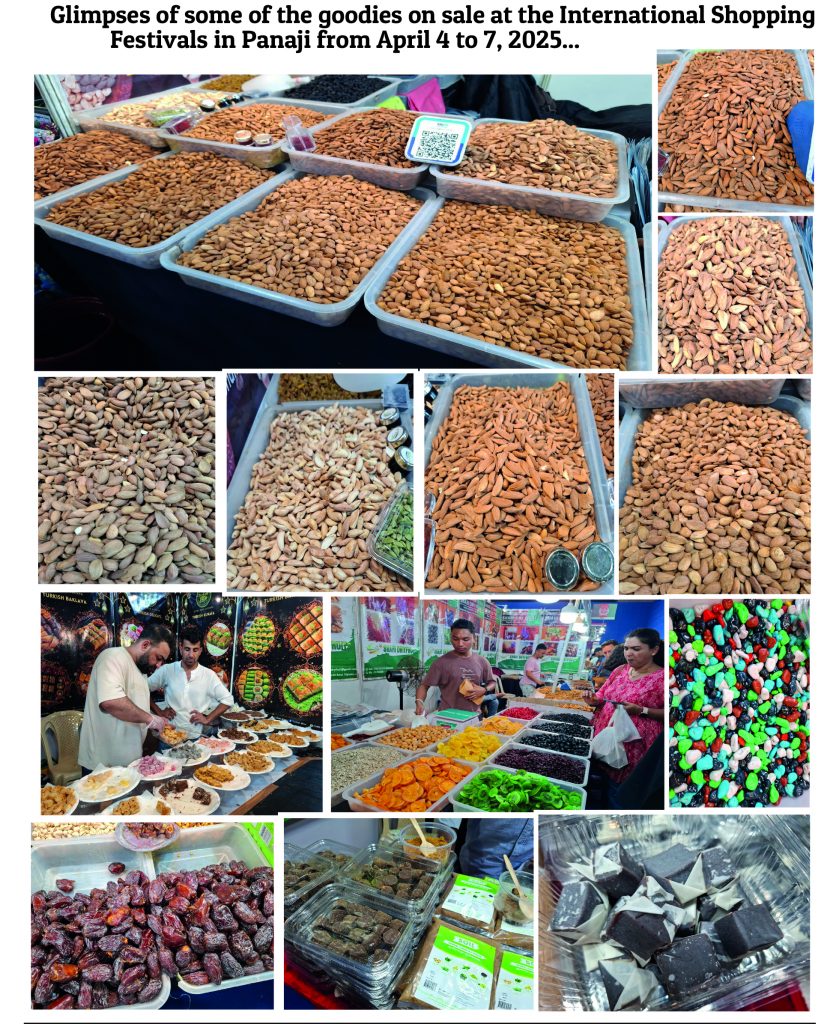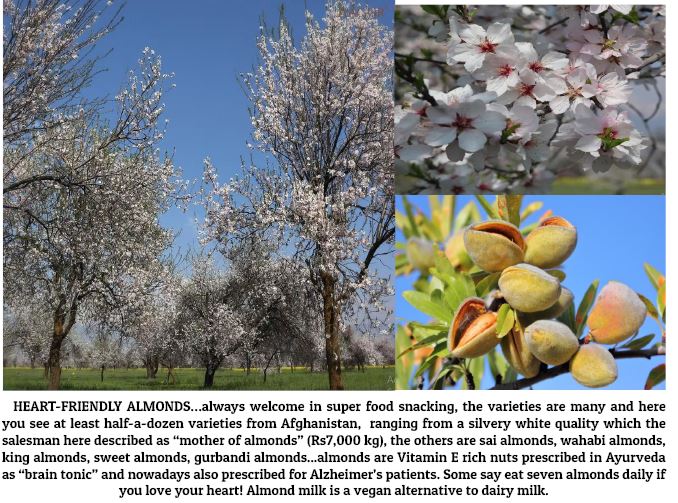By Tara Narayan
ALMONDS, badam. Who is as sweet as almonds! I have a friend whose husband calls her “Badam!” An endearment…well. What do you know about almonds except that they’re probably the first nut of power you may have been introduced to, apart from peanuts which are most common and usually considered as “poor people’s nuts” generally speaking. That’s because peanuts are commonly perceived as good protein and most economical to buy; most of us do get tempted to buy a podi full of roasted peanuts/groundnuts at most of the pheri fairs and zatra which take place every now and again in Goa…roasted peanuts large and small, yellow with turmeric gram or chana and vatana peas are like standard fare to buy for the kids to munch on.
But to stay with almonds every time there’s one of these international shopping festivals in town Panaji (this time the latest Thailand International Shopping Festival from April 4 to 7, 2025) we see these folk from Afghanistan with all the dry fruit of the desert lands they come from several varieties of almonds, walnuts, raisins, berries, seeds, candied fruit and this time a hot saffron drink too was being served at one of the half-a-dozen stalls set up at the Bambolim stadium where this exhibition sale took place.
At the Afgani stalls as usual I get mesmerized and couldn’t take my eyes of the almonds, more than half-a-dozen varieties from the amazing creamy white “mother of almonds” to the usual sweet varieties…freshness is proved with one of the sales boys here squeezing an almond to show off how rich in oil a certain almond variety is…the “mamra” almonds are generally considered superior to the “gurbandi” almonds. Mamra from Iran, Afghanistan, Kashmir may cost anything up to Rs3,000 kg plus, plus.
ALMONDS are generally perceived to be sweet nuts even if they don’t taste so sweet, maybe just a very wee bit if at all, that’s why almond milk is a favorite as much as coconut or peanut or soybean milk (we have quite a choice of milk options nowadays and one may make them at home given the sunlight, salt and time or so to speak). My perennial favorite is really coconut milk sweetened with a bit of jaggery and organically raised cow’s milk is fine too, be it hot or cold and especially in the “golden milk” formula (featuring turmeric, ginger, black pepper and with or without honey or jaggery sweetener for more agreeability).

ALMONDS (botanically Prunus amygdalus, same as Prunus dulcis) come from a tree species from genus Prunus and distinct because they come in a fancy lace-like shell (endocarp) – the nuts are enshrined within and easily extracted. Almonds are drupe fruit, comprising of outer hull and shell with the seed inside (not a true nut). But almond “nuts” are sold shelled or unshelled.
Nuts do turn rancid (unless stored in the refrigerator carefully), they have maybe a year’s natural shelf life. Ayurveda teaching says it’s best to soak almonds overnight before slipping off the skins and eating them as a brain tonic! That’s the traditional understanding in all the alternate systems of medicine including Unani I think – the nutritional brief is almonds are a super food with healthy fat, fiber, protein, magnesiam (magnesium being a most vital mineral most are deficient in)…some think Vitamin E when they pop a few almonds. It’s the antioxidant vitamin to curb inflammation in body beautiful. You may eat anything from seven to 23 almonds everyday if you wish for more muscle power.
This is to say include almonds in your daily eating habits, they’re said to be most heart-friendly nuts, lowering blood pressure, blood sugar and offering HDL cholesterol. The American Dietary Guidelines urge Americans to eat an ounce of almonds daily or 23 almonds! In India we say best to soak nuts overnight and eat next morning for that takes care of some nasty phytic acid, refreshes good enzymes and makes for better absorption of nutrients in body beautiful.
I think the idea is to eat a handful of nuts every now and again, say almonds, caju, walnuts, pista, add in a gorgeous dark date in your mix if you wish. With all the fuss that’s being made about protein deficiency in seniors’ diet I may add here that after eggs (having all the essential fatty acids), it’s soybeans which come close to being perfect protein food…I’m not surprised for in the oriental countries soybeans are a way of daily life – in the wet market place you will find vendors selling soybean milk, soybean cream (laced with palm jaggery sauce), soybean cheese (tofu soft and hard), and more soybean foods.
CLINICAL TRIALS
A 2022 analysis of 16 clinical trials including over 800 participants found that eating up to 60g, about 2.25 oz of almond daily, reduced two different markers of inflammation in the body. These finds support those of another study, which found that eating 56g) of almonds daily for 12 weeks reduced markers of inflammation among a group of over 200 participants between ages of 16 and 25.
Almonds protect oxidative damage and protect cells, oxidative damage being a major contributor to aging and disease. They’re the best source of vitamin E which lowers the rate of heart disease, cancer and Alzheimer’s disease too. Magnesium is also linked to reduction in insulin resistance, metabolic syndrome and type 2 diabetes, three things which are major health concerns today.
Go and find organically cultivated almonds to eat, my friends.
IN GOA of course caju or cashew nuts rule and come Christmas time one may see almond marzipan, cake and fudge rule the patisserie shops…we have almond cakes of various invention and ingenuity, not to forget “orchata” – an almond sherbet which is absolutely divine to sip on the rocks. It’s a Portuguese-time gift, don’t forget the Portuguese being part of Mediterranean belt love almonds. The almond tree is native to the Mediterranean countries which enjoy a cool weather…and the drupe fruit are also fruit of ancient Persia (now Iraq), and Afghanistan.
In India too we have our mountain states with Kashmir being the almond state although you will find “badam giri” orchards in Uttarakhand and Himachal Pradesh. The thin-skinned, slightly slim and slightly curved Kashmir “kagazi” almonds are raved about and the most expensive naturally.
FUNNY or not funny, till recently it was California in USA which produced almost 80% of the world’s almonds…but in recent times I think there have been some tragedies and I don’t think almonds and walnuts are cultivated organically or wildly, although they are the most marketed and eaten around the world! I prefer Afghan or Kashmir dry fruit.
Which reminds me how almond trees in blossom are said to make for as pretty a picture as say the Japanese cherry blossom scene…yes, plums and cherries are siblings of the Prunus family. In Kashmir’s famed wazwan or marriage cuisine almonds, walnuts and other dry fruit of the local orchards feature in delicate pilaf, various gravies, even the tandoor array of roti. Almonds and walnuts are royalty amongst nuts as also the harder to find pine nuts (pine trees in Kinnaur) which enjoy such a short shelf life and feature in Italian pesto sauces for spaghetti making. In India parents soak a handful of almonds overnight in water and both children and adults will eat a few almonds (skins peeled) as breakfast routine. Almond crumble, almond cream, almond butter, almond puree, almond milk…feature in curries and soups around the world.
Bitter almonds are also value and in Portugal you may have heard of bitter almond liqueur and liquor “licor de amendo” from the Algarve region. As much liked as the Italian amaretto and similar in flavor I’m told, I haven’t tasted it, but know of another Crème de Noyauz as an almond-flavored crème liqueur.
Finally, almonds are the world’s most popular tree nuts, a small handful of almonds would be say about 164 calories, six grams of carbohydrates, 3.5 grams of fiber. In conclusion, almonds are super nuts of good nutrition, anti-inflammatory, anti-aging, the fountain of youth nut.
